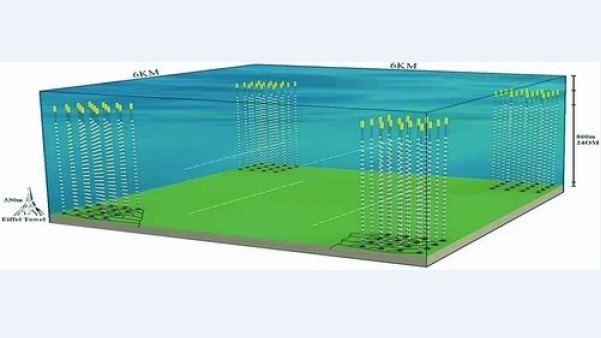
Schematic diagram of the high-energy underwater neutrinos telescope. /Chinese Academy of Sciences
Schematic diagram of the high-energy underwater neutrinos telescope. /Chinese Academy of Sciences
Chinese scientists are working on a blueprint for a gigantic telescope to observe neutrinos, one of the most abundant particles in the universe, from deep within the seas or lakes.
The facility, designed to have a roughly 30-cubic-kilometer volume, will be submerged to a depth of more than 1 kilometer, said Chen Mingjun, lead researcher of the project at the Institute of High Energy Physics under the Chinese Academy of Sciences.
The aim of building such an underwater telescope is to detect high-energy neutrinos. The particles are thought to be produced outside the solar system. According to Chen, detecting the neutrinos that pass through the telescope will contribute to solving a century-old scientific puzzle of the origin of cosmic rays.
In the early 1900s, scientists discovered that Earth is constantly bombarded by energetic particles from outer space called cosmic rays. In 2021, China's Large High-Altitude Air Shower Observatory (LHAASO) detected 12 sources of gamma rays that are thought to come from the same sources as cosmic rays.
Chen said one popular hypothesis is that the high-energy neutrinos and gamma rays are potentially produced simultaneously when high-energy cosmic rays originate.
"If we can detect the two particles together, we can determine the origin of the cosmic rays," said Chen.
When passing through the water, neutrinos will collide with the atomic nucleus and produce secondary particles, emitting light signals that can be captured by detectors underwater.
Some research already hints at this possibility, and Chen believes that neutrino detection could trace the origin of this mystery space radiation.
As to why scientists deploy the telescope deep in the water, Chen said from 1 km below the surface, no sunlight penetrates the darkness; and since photosynthesis can not take place, there are no fish or microorganisms, either.
"The clean water will help increase the chance of detecting neutrino signals," Chen explained.
Similar foreign underwater neutrino detectors include the cubic-kilometer-scale IceCube Neutrino Observatory, deployed near the South Pole, and the Baikal-GVD neutrino telescope, currently covering 0.5 cubic kilometers in Lake Baikal.
The planned Chinese detector will be much larger, Chen said. "It will be a 30-cubic-kilometer detector comprising over 55,000 optical modules suspended along 2,300 strings."
In February, his team completed the first sea trial to test the detecting system at a depth of 1,800 meters underwater.
Most members of Chen's team have spent years in the study of cosmic rays. They have participated in the project LHAASO, a giant cosmic ray detector located 4.41 km above sea level in southwest China's Sichuan Province.
However, hunting extraterrestrial neutrinos from deep water is more problematic than on the mountain, Chen said, adding that current challenges his team faces include developing detectors to meet higher requirements on waterproofing, as well as the high costs of underwater equipment and operations.
Source(s): Xinhua News Agency